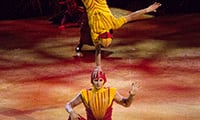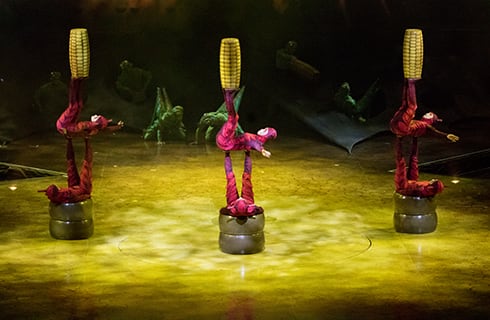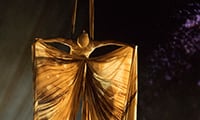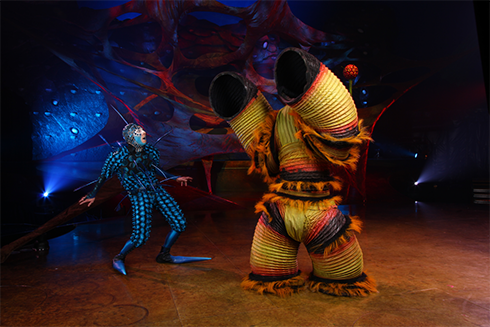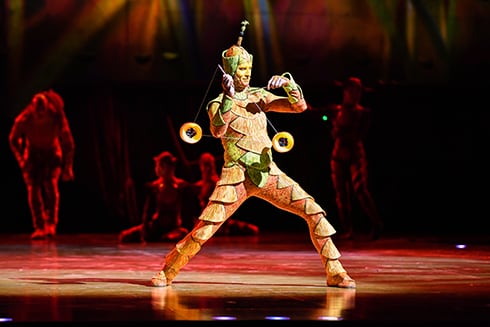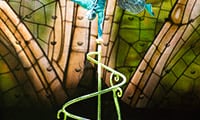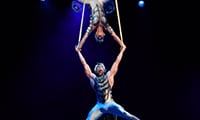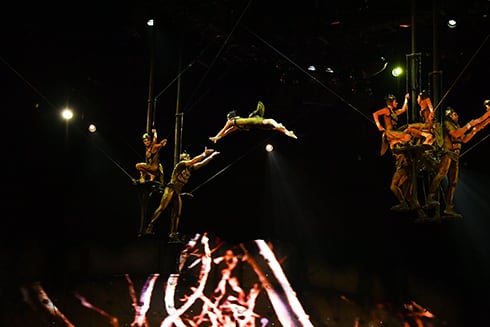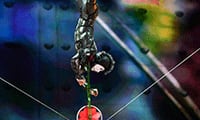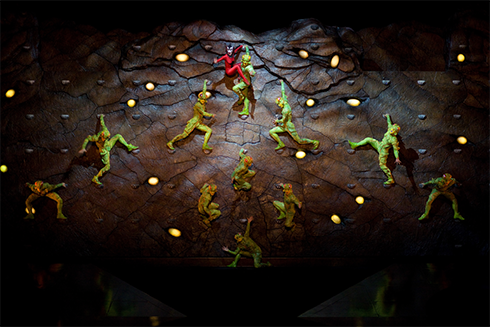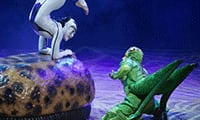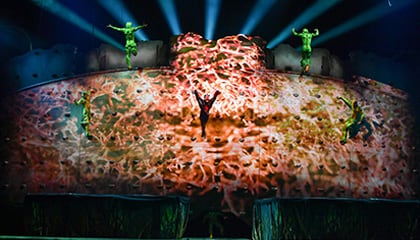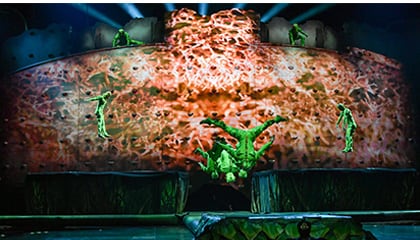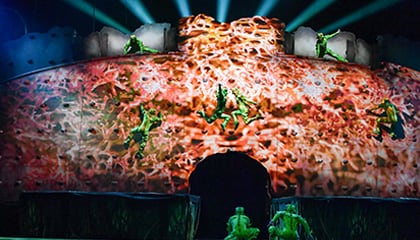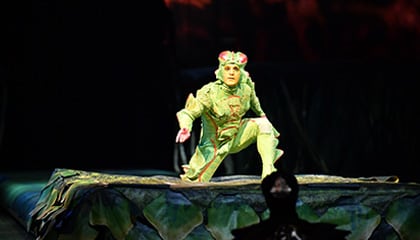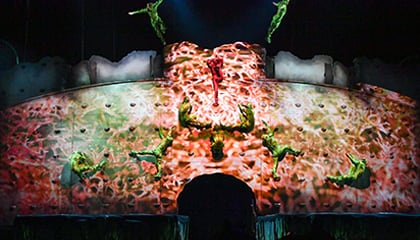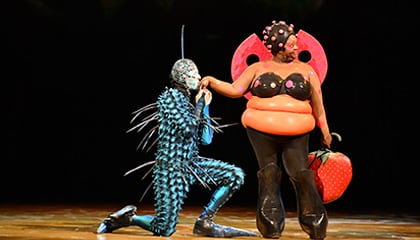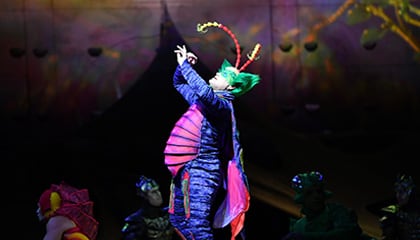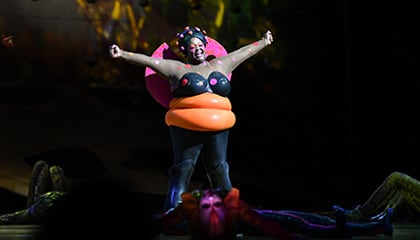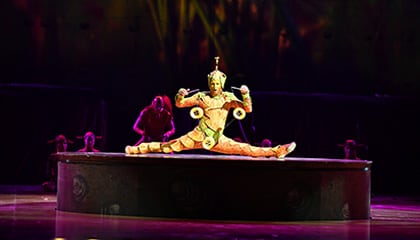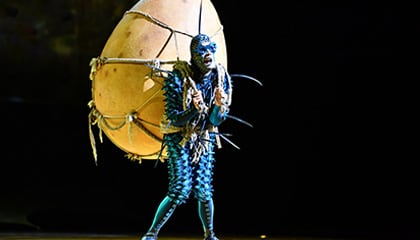Complicity with the world of insects
Liz Vandal, the costume designer for OVO has a special affinity for the world of the insects. “I’ve always had passion for them,” she says. “When I was just a kid I put rocks down around the yard near the fruit trees and I lifted them regularly to watch the insects who had taken up residence underneath them. I petted caterpillars and let butterflies into the house. So when I learned that OVO was inspired by insects, I immediately knew that I was in a perfect position to pay tribute to this majestic world with my costumes.”
Liz has a signature style inspired by futuristic superheroes and by suits of armour from all eras. These two sources inform her designs for the OVO costumes. Flattering lines and an elongated, corseted look are a nod to the world of super heroes while the segmented shells on many of the garments alternate between hard and soft, much like the armour and the bodies of knights in the Renaissance.
Evocation rather than imitation
Liz’s first challenge was to imagine a way to evoke insect without copying their actual anatomy. “The solution was to connect with the feeling of being face to face with a spider, a cockroach or a butterfly,” she explains. “Then I made detailed drawings of designs that interpreted their morphology. For example, the dragonfly’s wings are evoked by pants made of veined lace, and the mosquito’s stinger by a ‘Mohawk’ of fine red stems. The idea of the shell also became a metaphor, since the word ‘insect’ refers to ‘sections’. This revelation consolidated my approach.”
Organic/Synthetic
Liz drew on the wealth of experience and know-how of Cirque’s costume shop to put it all together. “Together we developed techniques of pleating fabrics to provide three-dimensional muscle, volumes and shells,” she says. “The result is a sort of organic origami. The most obvious example of that is the crickets’ costumes. The team also explored the textures of wings and shells using the sublimation technique to poeticize them and give them an evocative texture.”
In a play of colors and patterns, Liz implemented variations on a theme by incorporating thin lines on the ants and crickets, and pleated abstract transparent outfits for the dragonflies. She also used materials to suggest insects’ shells, and lacy fabrics for the wings and soft sections of their bodies. To enable certain characters such as the mosquito to move, she placed sections of shell within other sections, which open and close to reveal the soft body inside.
Crickets – symbols of the colony
Ten crickets are the key insects in the show. At times, they have detachable legs that break away from their bodies, which the impression that there is an insect invasion going on. “I have a particular soft spot for these characters,” she says, “because their costumes are so sexy, graphic and vibrant.”
The Foreigner is a character who lands in the middle of OVO. He is a fly in vintage suit who only reveals his true nature when he falls for The Ladybug. After his transformation, he wears a costume of bristling spines. His lanky, angular form contrasts with the roundness of The Ladybug.
Sources of inspiration
Liz Vandal took her inspiration from many sources, including certain fashion designers such as Pierre Cardin, who focused on graphic lines and geometric shapes. She was also inspired by the slashed sleeves of Renaissance garments.
Liz and her team in the costume shop have exploited the permanent pleating technique developed by Japanese designer Issey Miyake, which gives a certain rigidity to material and creates an organic effect. “We pushed this technique even further,” she says, “by printing on colored materials, sublimation and eroding the fabric not only to stiffen it, but also to give it a metallic sheen.”
SOME HIGHLIGHTS
- Most characters have two versions of their costumes: the first, more lightweight and functional, for their acrobatic performance, and the second, more richly detailed and heavier, for their life in the community.
- The initial cricket costumes required 75 hours of work each because of their complexity and the need to give them rigidity while maintaining the flexibility and expandability of the material.
- Microscope photography of insects reveals that the materials used in the costumes are remarkably similar in structure to the bodies of insects.
